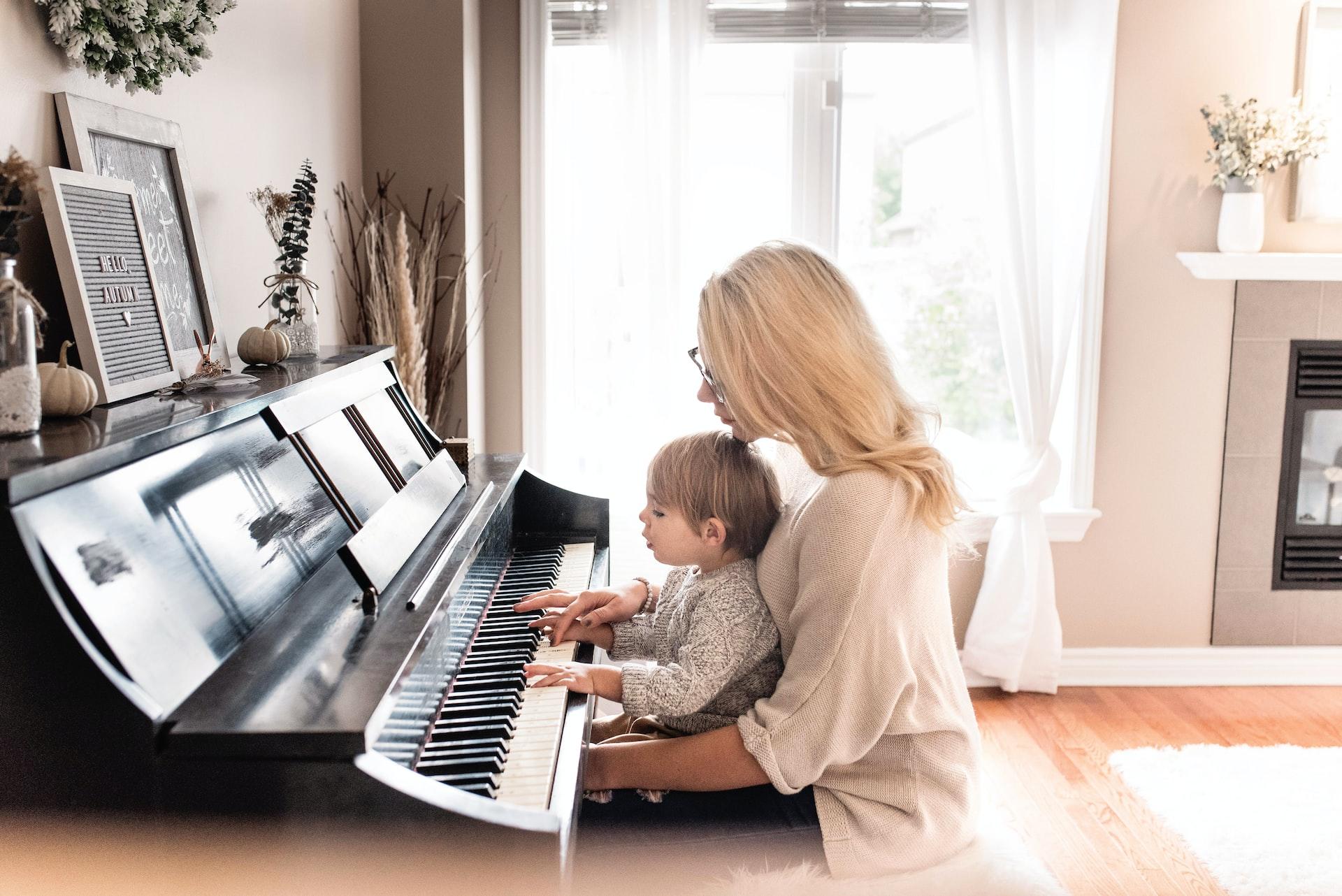Bread and butter, tea and biscuits, beer and crisps: as the old song says, things are better in twos. So why not piano playing? But it has to be the right two things. Granted, paper goes well with envelopes but paper and pen would be the better pairing.
Playing with the right partner is the essence of piano duets but not its most remarkable aspect. A pair of guitarists might play a duet on their respective instruments. But you're not likely to see a pair of guitar players plucking away at one instrument's strings. By contrast, a piano bench and keyboard have plenty of room for two players.
Such an accommodation allows for endless musical possibilities. From lighthearted pieces like the Chopsticks Waltz to the wildly complex Sonata for Two Pianos, playing duets is a great skills builder. Even beginner piano players can practise duets as long as they:
- play at about the same level of proficiency
- they've practised the pieces on their own
- they agree on which 'responsibilities' each player will have
- their musical expressions are complementary
These four points highlight the fact that playing piano duets is not simply a matter of two piano players who know the same song tinkling the ivories. There is some work, planning and coordination involved. Let's go over those particulars now and then, we'll look at some tunes ideally played as a duet.

What It Takes to Play a Duet
As mentioned in this article's introduction, even beginner piano players can build their skills by playing duets. Thus, we can conclude that playing with a partner is not technically difficult. But it does take a certain mindset to share one's spotlight. So getting your head around coordinating with another player is the first step towards playing duets.
Music is universal but musical expression is very personal. It's difficult to find someone who shares exactly how you feel when playing a certain piece. More importantly, you have to find a partner who wants to communicate to listeners the same things you do. As with any partnership, playing a duet involves a fair amount of compromise.
Find out about starting piano lessons in Glasgow.

Let's say that you've recently become enthralled with jazz piano but your teacher has paired you with a player who prefers classical pieces. Despite many differences between the two genres, that could turn out to be an ideal pairing because both allow for a generous amount of interpretation. You'll just have to coordinate with your partner on the interpretation you want.
Duet music, like jazz and classical music, is fundamentally ensemble music. That means that each player has their time to shine while the other(s) rests. Fitting the various parts together is the key to playing them all well. So to play duets well, you must constantly count your beats and measures in perfect synchronicity, even as you rest.
We mentioned earlier that each half of the duo must practise the pieces on their own. You should both practise with sheet music of the same edition to avoid any marking differences. And both of you should number every measure so that, if one of you loses your place, your partner can tell you which measure number to pick up on. You have to be tolerant of your partner's occasional lapses because you'll likely have some, too.
Who Does What When Playing Duets?
From a duet's perspective, the piano's keys are roughly divided between bass and treble. The bass end is called segundo and is generally more challenging to play. The treble end is logically called primo; it carries the melody and often plays flourishes. Primo is often considered the simpler part.
Typically, the segundo works the piano's pedals though that's not written in stone. The youngest segundo players might not have legs long enough to work the rightmost pedal. And besides, pedalling is arbitrary, at least to an extent. So this matter, too, must be coordinated.
You should also agree beforehand one who will turn the score's page. Typically, whichever player is resting at the end of the page will turn it. But if you're both playing when you get to the bottom of the page, you should have a plan in place.
You can read about where to find the most effective piano lessons in Leicester here.

Playing Piano Duets: Best Practices
We've covered many of the recommended practices already but now, let's put everything together. When you decide or are assigned to play a duet, you should first learn the piece you'll play. Feel free to play around with it while you're at it. Sample your pedalling and alter the tempo a bit, just to see what else the song has to say.
Once you're intimately familiar with this song, listen to your partner play it. How is their phrasing different from yours? Does it have different tonal qualities? Go over these and other questions together and then, mark your scores to reflect your playing preferences.
You should also number every measure and label each section. Once you've both marked your scores, you can practise counting. Before playing from the score, you can synchronise your playing with scales and arpeggios, counting off the notes as you play them. That will help you get familiar both with counting and with hearing your partner as you play.
Your piano technique and form don't have to be mirror images of your partner's but they have to be close enough to complement each other. When you both have the piece's technical aspects mastered, you can experiment with expression. Just remember that the melody must carry above any other dynamics.
You might, for instance, shape successive phrases so that their climaxes contrast with quieter, more subtle notes. You might conclude that a triumphant crescendo requires an equally vibrant decrescendo. However you decide to interpret this piece, mark your score and stick with your choices.
See where you can take exceptional piano lessons in Leeds here.
Renowned Piano Duet Songs
Some duet hopefuls rely on their piano teachers to select their pieces and others choose for themselves which songs they want to play. That only begs the question of which catalogue you should choose your songs from. Not every piece is clearly marked as suitable for a duet. Others may require a lot of arranging before they could become a satisfying duet.
The following songs are uniquely suited for two sets of hands. They're chosen from across the musical spectrum, from famous pop songs to show tunes and classical pieces. Some are easy enough for beginners to play while others represent more of a challenge.
The ever-popular Chopsticks Waltz falls in the former category. Euphemia Allen composed this one-octave-spanning piece in 1877; her brother helped publish it under the Arthur de Lulli pseudonym. The original score included the very specific instruction that players' hands should be turned sideways, little fingers down. That way, they could best make the chopping motions that gave this piece its name.
Solo or with a partner, Chopsticks is a lot of fun to play but so is Heart and Soul. Hoagie Carmichael's 1938 jazz tune was simplified so piano students could learn how to play duets with it. The simplified version has become the most popular version of this song. That's a shame because its chord progression underpins many 50s-era American songs.
Hungarian composer Franz Liszt is not known for his easy piano pieces but even beginner duetters could play Hungarian Rhapsody No 2. At times lyrical and others dramatic, it offers the partners great expressive opportunity. It also offers them an excellent chance to improve their playing speed and dexterity. Liszt himself arranged the duet version, he couldn't resist leaving in a few frenetic measures for each part.
Andrew Lloyd Webber has given the world a vast catalogue of music but none of his pieces is more hauntingly beautiful than All I Ask of You. This tune weaves classical elements into theatre panache, all highlighted by the piece's wistful tone. The treble desires and the bass asserts. One might say that All I Ask of You challenges the players' expressive abilities more than their technical skills.
If you're looking for a good piece for duelling pianos - two pianos and two players, Mozart's Sonata in D Major would be great to cut your teeth on. It's more advanced and substantially more intricate than any of the music mentioned so far. But then, duelling pianos are a cut above sitting on the same bench as your partner-in-playing.
You won't be able to whisper your counts or help each other keep track of where in the score you are. You will have to be perfectly synchronised with your partner, as Billy Joel and Elton John are when their pianos duel. So seamless is their performance that you can't hear when one stops playing and the other starts. Their rendition of Piano Man is a stellar example of such.
You might not learn everything you need to know about the piano from those two legends but they certainly exemplify what piano duets are all about. Balance, accord, synchronicity and respect define piano duets. Rest assured your technical playing skills will progress apace. But those qualities are the ones needed to play satisfying duets.
















